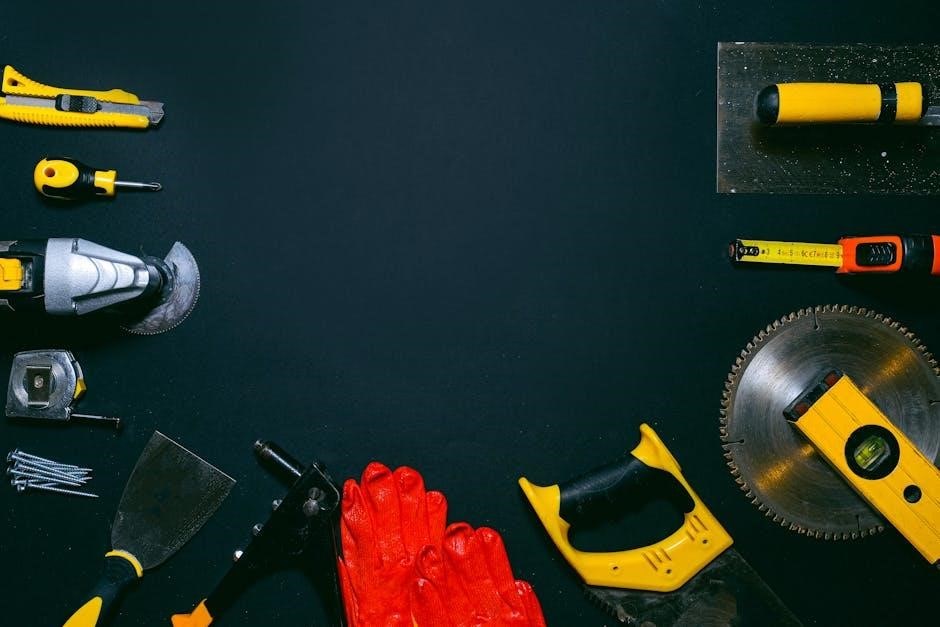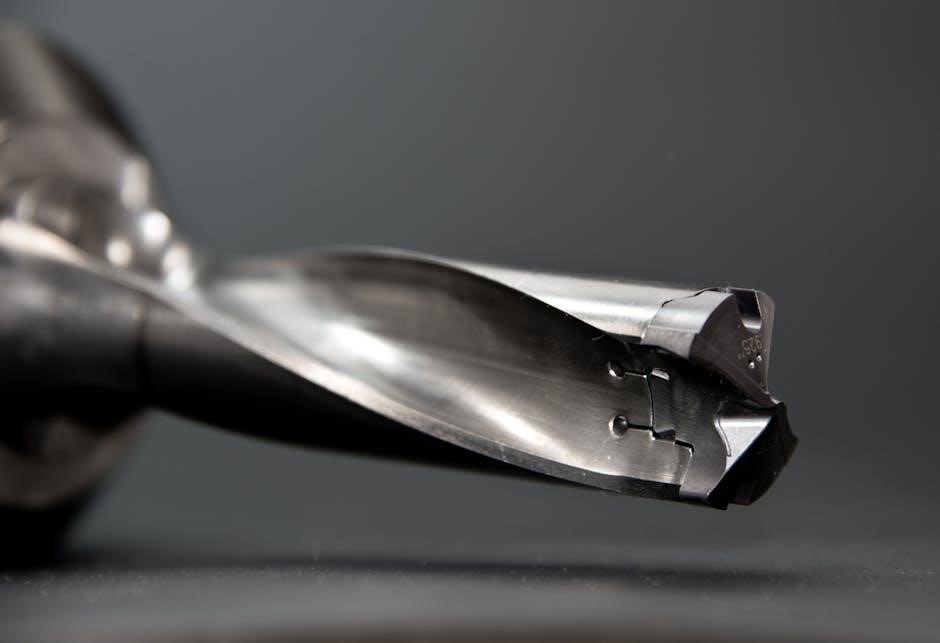Drill and tap guides are essential tools for creating precise holes and threads, with
- step-by-step instructions and charts available online to ensure accurate results and efficient workflow processes always․
Understanding the Basics of Drilling and Tapping
Drilling and tapping are fundamental processes in various industries, including metalwork and manufacturing, where creating precise holes and threads is crucial for assembling and joining parts together․
The drill and tap guide provides a comprehensive overview of these processes, covering the basics of drilling, tapping, and thread creation․
With the help of a drill and tap guide, users can understand the different types of drill bits and taps available, including their applications and uses․
A drill and tap guide typically includes a chart or table that outlines the relationship between drill bit sizes and tap sizes, making it easier to select the correct tools for a specific job․
By understanding the basics of drilling and tapping, users can improve their skills and efficiency, reducing errors and improving the overall quality of their work․
The guide also covers important topics such as thread pitch, thread count, and material considerations, all of which are essential for achieving professional results․
Overall, a drill and tap guide is an essential resource for anyone involved in drilling and tapping operations․

Drill and Tap Size Chart
Drill and tap size charts provide essential information for selecting the correct drill bit and tap sizes for various applications and materials using tables and diagrams effectively always․
Importance of Using the Right Drill Bit Size
Using the correct drill bit size is crucial for achieving accurate and precise results in drilling and tapping operations․ The right drill bit size ensures that the hole is properly sized for the tap, allowing for efficient and effective thread cutting․ A drill bit that is too small can result in a hole that is too tight for the tap, leading to difficulties in tapping and potentially causing damage to the material or the tap itself․ On the other hand, a drill bit that is too large can result in a hole that is too loose, leading to a weak thread and potentially causing the screw or bolt to strip․ By using the correct drill bit size, users can avoid these common pitfalls and achieve professional-grade results․ This is especially important in applications where precision and accuracy are critical, such as in metalwork, woodworking, and other industries where drilling and tapping are common operations․
Considerations for Thread Pitch and Compatibility
When working with drill and tap guides, considering thread pitch and compatibility is essential for achieving successful results․ Thread pitch refers to the distance between threads, and it is critical to ensure that the thread pitch of the tap matches the thread pitch of the screw or bolt being used․ Incompatible thread pitches can result in a weak or faulty thread, leading to premature failure or damage to the material; Additionally, users must consider the compatibility of the tap with the material being drilled, as some taps are designed for specific materials or applications․ By carefully considering thread pitch and compatibility, users can ensure that their drilling and tapping operations are successful and produce high-quality results․ This requires a thorough understanding of the materials and tools being used, as well as attention to detail and careful planning․ Proper consideration of these factors is crucial for achieving professional-grade results․

Removing a Broken Tap
Using a tap extractor is often necessary to remove broken taps from materials, requiring careful handling and application of gentle force to avoid further damage to surrounding areas always․
Methods for Extracting a Stuck Tap
Extracting a stuck tap requires careful consideration and application of appropriate methods to avoid further damage․
Using lubricating oil can help loosen the tap, while applying gentle force in the opposite direction may help dislodge it․
A harder drill bit can also be used to drill into the broken tap, treating it like a material being processed․
Additionally, a tap extractor is a handy tool often kept in machine shops for emergency situations, designed to remove stuck taps efficiently․
It is essential to identify the correct method for extracting the stuck tap, taking into account the type of material and the size of the tap․
By applying the right technique and using the appropriate tools, it is possible to successfully extract a stuck tap without causing further damage to the surrounding material․
The process of extracting a stuck tap can be challenging, but with the right approach and tools, it can be accomplished efficiently and effectively, saving time and reducing costs․
Using a Tap Extractor for Emergency Situations
A tap extractor is a valuable tool for emergency situations where a tap becomes stuck, providing a safe and efficient way to remove it․
The extractor works by gripping the tap and applying a controlled amount of force to twist it out, minimizing the risk of damage to the surrounding material․
It is essential to use a tap extractor correctly, following the manufacturer’s instructions and taking necessary precautions to avoid injury or further damage․
In emergency situations, a tap extractor can save time and reduce costs by allowing for the quick and efficient removal of a stuck tap, getting the job back on track․
The tap extractor is a specialized tool designed specifically for this purpose, making it an indispensable asset for any workshop or machine shop․
By having a tap extractor on hand, users can be prepared for emergency situations and ensure that they can complete their work efficiently and effectively, without unnecessary delays or complications․

Drill and Tap Guide Tools
Drill and tap guide tools include various devices and
- accessories
designed to assist with drilling and tapping operations, ensuring accuracy and efficiency in different applications and industries always․
Features of the TTT001/M Tap Guide
The TTT001/M Tap Guide is a specialized tool designed to assist in the re-drilling and re-tapping of damaged surfaces, featuring a compact design and durable construction for optimal performance and longevity․
The guide is equipped with two countersunk mounting screws, allowing for secure attachment to existing surfaces, and is compatible with a range of tap sizes and thread pitches․
A key feature of the TTT001/M Tap Guide is its ability to accurately align the tap with the damaged hole, ensuring precise and efficient repair operations․
The guide is also designed to be easy to use, with a simple and intuitive interface that minimizes the risk of errors and reduces the time required for repair․
Overall, the TTT001/M Tap Guide is a valuable tool for anyone working with drills and taps, providing a reliable and efficient solution for repairing damaged surfaces and restoring optimal functionality․
The guide is suitable for use in a variety of applications, including metalwork and other industries where precise drilling and tapping are critical․

Applications of Drill and Tap Guides
Drill and tap guides are used in metalwork, woodworking, and other industries for precise hole creation and threading with various materials and tools always available online․
Drilling and Tapping in Metalwork
Drilling and tapping in metalwork involves creating precise holes and threads in metal materials, which is a crucial process in various industries, including construction, manufacturing, and engineering․
The process requires careful planning and execution to ensure accurate results, and drill and tap guides play a vital role in achieving this․
With the help of these guides, metalworkers can create holes and threads that are perfectly aligned and sized, which is essential for ensuring the stability and durability of metal structures and components․
The use of drill and tap guides in metalwork also helps to reduce errors and improve efficiency, as they provide a clear and accurate template for drilling and tapping operations․
By following the guidelines and charts provided, metalworkers can ensure that their drilling and tapping operations are precise and effective, resulting in high-quality metal products and structures․
The importance of accurate drilling and tapping in metalwork cannot be overstated, as it has a direct impact on the safety and performance of metal components and structures․
Creating Threaded Holes for Machine Screws
Creating threaded holes for machine screws is a critical process that requires precision and accuracy, and drill and tap guides are essential tools for achieving this․
The process involves drilling a hole and then tapping threads into it, which allows the machine screw to be securely fastened․
The drill and tap guide provides a template for drilling the correct size hole and tapping the correct threads, ensuring a precise fit for the machine screw․
This is particularly important in applications where the machine screw will be subject to stress or load, as a poorly threaded hole can lead to screw failure or stripping․
By using a drill and tap guide, individuals can create threaded holes that are strong, durable, and precisely sized for the machine screw, resulting in a secure and reliable fastening system․
The guide helps to ensure that the threads are cut correctly, with the right pitch and depth, and that the hole is drilled to the correct size and location․



Leave a Reply
You must be logged in to post a comment.